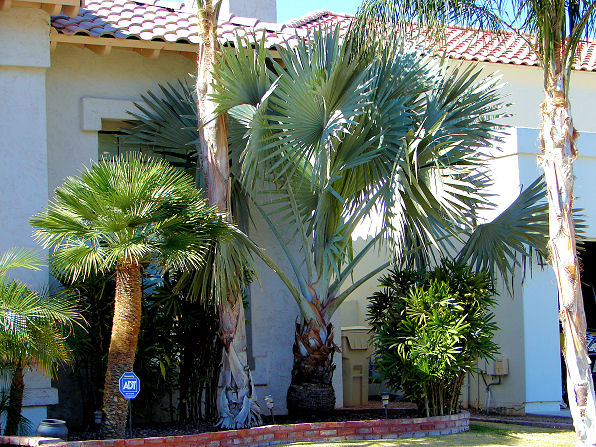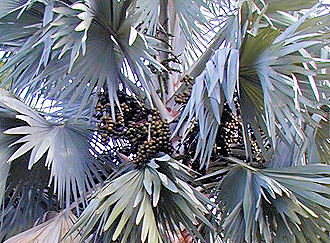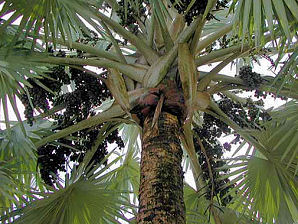Xeriscape Landscape Plants & Flowers
For The Arizona Desert Environment.
Pictures, Photos, Images, Descriptions, & Reviews.
Bismark Palm, Bismarckia nobilis.
We Are Proud Of Our SafeSurf Rating!
Click On Any Of The Following Links By Amazon.Com
To View Tools For Desert or Arizona Gardening. No Obligation!
 |
| Bismark Palm, Bismarckia nobilis. Arrowhead Ranch, Glendale, Arizona. January 21, 2006. |
|---|
 |  |
| Bismark Palm. Bismarckia nobilis. With Dates. | Bismark Palm. Bismarckia nobilis. With Dates. |
|---|
Bismark Palm Tree.
We wish to thank Wikipedia, the free encyclopedia for some of the information on this page. We share images and information with Wikipedia. A spectacular tropical fan palm with a stout trunk and massive blue-grey fan leaves up to nine feet across. There is also a green leaved form. It is very sensitive to transplanting, but root pruning will help avoid shock to the plant. This massive tropical palm commands attention and demands respect wherever it is grown. It grows a single smooth trunk on mature specimens but the younger plants retain their old leaf bases. This palm may reach aheight of 50 - 60 feet and a spread of 20 feet or more. The young specimens that have yet to form a trunk show off their full crowns of about 25 leaves very quickly! The huge palmate leaves are bright light blue, waxy and are up to 10 feet across. They are supported on 6 foot stems that can be as much as 10 inches in diameter. The leaf bases will split where they attach to the trunk and the leaf stems are have small sharp teeth. Bismarck Palm is adaptable to many kinds of soil and it prefers full sun but is tolerant of some shade. Once established it is drought tolerant. Because of its huge size and mass, the Bismarck palm is not recommended for small yards. It is best planted where it can be the focal point of the landscaping. Bismarckia nobilis is the only species in the genus and it is a relatively recent introduction to Arizona landscapes. Bismarck palm is rapidly becoming popular since it is not only spectacular but it is drought tolerant and not as subject to disease and nutritional deficiencies as most other landscape palm species are. It is named after Otto von Bismarck, former chancellor of Germany. It is one of the most common palms in Madagascar. This palm is a difficult tree to transplant, so use care when pruning not to damage the lower trunk or roots.
Quick Notes:
Height: Can reach an ultimate height of 50 - 60 feet with a spread of 20 feet or more
Flowers: Its flowers, unisexual on dioecious plants, are small, whitish, fragrant, clustered in axillary spadices up to 3 feet long markedly bent downwards by their fruit weight.
Flowering Time: Southern Arizona, March - April. Phoenix Area, April - May.
Leaves: The leaves are huge palmate leaves that are bright light blue, waxy and are up to 10 feet across. They are supported on 6 foot stems that can be 10 inches in diameter.
Trunk: Normally up to 18 - 24 inches in diameter.
Soil pH requirements:
Sun Exposure:
Elevation: Can be found growing from 0 - 2,000 feet.
Habitat: Lower elevations. It grows well in sand, sandy loam, clay and other heavy soils. It needs good drainage and aeration. A sunny, warm, and well drained position. Drought, and frost tolerant. Adaptable to most types of soil.
Miscellaneous: Photos Taken at Arrowhead Ranch, Glendale, Arizona. January 21, 2006. Needs a very large area to grow.
|
We Are Proud Of Our SafeSurf Rating!
Click On Any Of The Following Links By Amazon.Com
To View Tools For Desert or Arizona Gardening. No Obligation!
| © 1966 - Present, Audrey, Eve, & George DeLange |





